|
  The sun is a star, and it is very large and very far away. Its distance from Earth is about 149 million kilometres. The light from the sun takes about 8 minutes to get here, travelling at 300,000 kilometres per second. However, despite the fact that the sun is so far away, we're going to show you a simple method for calculating the sun's diameter, so we can find out how big it really is.
The sun is a star, and it is very large and very far away. Its distance from Earth is about 149 million kilometres. The light from the sun takes about 8 minutes to get here, travelling at 300,000 kilometres per second. However, despite the fact that the sun is so far away, we're going to show you a simple method for calculating the sun's diameter, so we can find out how big it really is.
To measure the sun's size, you will need a stiff piece of very light cardboard, a sheet of white paper, a pin, a ruler, and a calculator. Before we start, though, we should caution you: Never ever look directly at the sun with your eyes, or through a telescope, camera, or sunglasses. Staring at the sun for even a few seconds can permanently damage your eyes. Not only are we going to measure the sun, but you'll learn a safe way to look at an image of the sun without damaging your eyes. The first thing you need to do is use the pin to make a tiny pinhole in the centre of the cardboard.This pinhole will act as a tiny camera aperture, letting the light from the sun through and making an image of the sun on your piece of paper. In fact, pinhole cameras were the first sort of camera invented a century or two ago. When you hold up the paper you will see a tiny perfect image of the sun, just like a photograph! 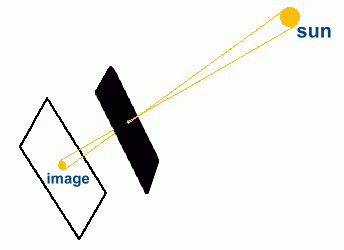 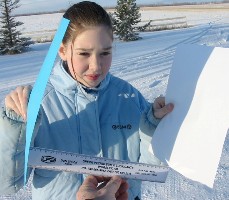 We tried the experiment ourselves, to see what kind of results we'd get. In a stiff piece of paper we made a pinhole, about the size of the end of a paperclip. On a day with bright sunlight, we held the pinhole up to the sun, and positioned a piece of white paper on the other side at a spot where we could see an image of the sun on the paper.
We tried the experiment ourselves, to see what kind of results we'd get. In a stiff piece of paper we made a pinhole, about the size of the end of a paperclip. On a day with bright sunlight, we held the pinhole up to the sun, and positioned a piece of white paper on the other side at a spot where we could see an image of the sun on the paper. As you move the pinhole farther away from the paper the image gets bigger; we chose a distance where the sun image was big enough to measure its width reasonably accurately. A second person is needed to measure the distance of the paper from the sheet with the pinhole. 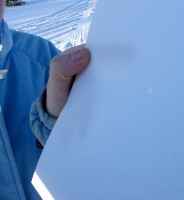 It's very difficult to determine when the sun image is actually in focus; we didn't worry about that, but just made sure the image was wide enough to measure.
It's very difficult to determine when the sun image is actually in focus; we didn't worry about that, but just made sure the image was wide enough to measure.We wanted to see what kind of results we could get with quick, simple measurements, so we weren't too careful about measuring the distance exactly between the pinhole and the image. A more accurate result might be found by using stiffer cardboard. At 30 cm (300 mm) between the two sheets of paper, the image of the sun on the white sheet was about 3 mm across. Now let's do the calculation ... 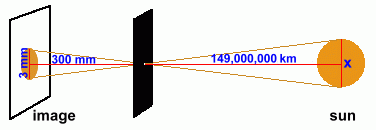
Here is the diagram with all the measurements marked. We know that the distance to the sun is about 149 million kilometres. To make the diagram clearer, we've exaggerated the width of the sun's image, and of course shortened the distance to the sun. 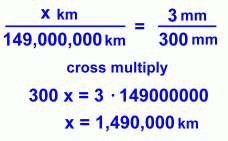 This is a simple ratio question, since the triangles on the left and right are similar.
This is a simple ratio question, since the triangles on the left and right are similar.Note that the units on the same side of each side of the proportion (pair of equal fractions) must be the same, but the units can be different on opposite sides. Cross-multiplying and solving gives a result of 1,490,000 km for the width of the sun. How close did we come? Remarkably, with very little effort and not much thought to precision, we obtained a result for the diameter of the sun which is close to the actual value of about 1,390,000 kilometres. We were off by just 7%! |